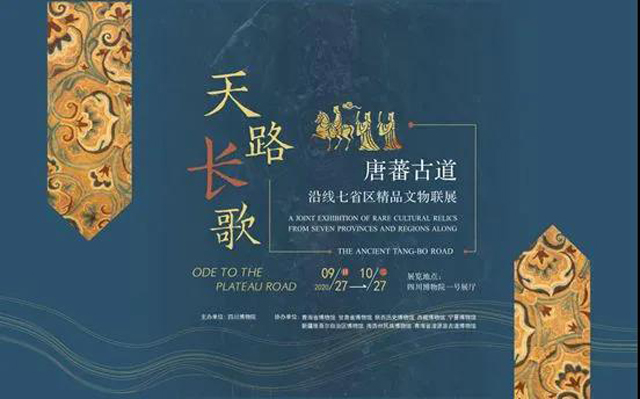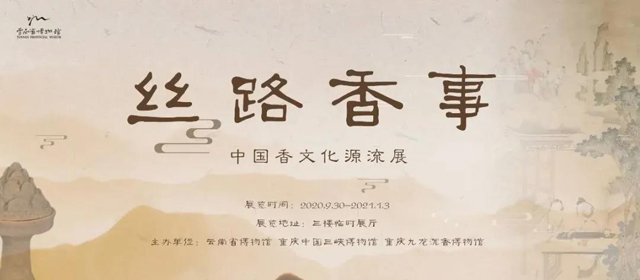The opening ceremony of the 2021 Silk Road Week was held at China National Silk Museum(NSM) on June 18, 2021. During the event, the International School for Museology, Nanjing University of the Arts a<a></a>nd NSM jointly released the Top 10 thematic exhibitions on the Annual Report of the Cultural Heritage on the Silk Roads 2020. The Top 10 exhibitions were based on the thematic exhibitions involved in the field of Silk Road Cultural Heritage in 2020. They were screened by man-machine integration a<a></a>nd the experts f<a></a>rom the exhibition team of the Annual Report were invited to make recommendations a<a></a>nd comments. According to their votes, the final Top 10 lists for thematic exhibitions are as follows:
1. Tang-Tibet Ancient Road: Joint Exhibition of Cultural Relics f<a></a>rom Seven Provinces
Dates: September 27, 2020 – October 27, 2020
Venue: Sichuan Museum, Sichuan, China

Overview:
In order to increase the visibility of the Tang-Tibet Ancient Road, the exhibition scrupulously selects 189 items/sets of exquisite artefacts f<a></a>rom Qinghai, Gansu, Shaanxi, Ningxia, Xinjiang, Tibet a<a></a>nd Sichuan that witness exceptional values of the ancient road for the cultural exchanges between Hans a<a></a>nd Tibetans as well as its significance for the relevant regions.
The new installation integrates into the initial version of the travelling exhibition Tibetan archaeological sites in Sichuan such as Tibetan stone carvings in Shiqu County a<a></a>nd the Tibetan graves of Galazong in Luhuo County. The Shiqu County stone carvings testify to another transportation route between the Tang dynasty a<a></a>nd Tibet mentioned in historical accounts a<a></a>nd which is to the south of the traditional path. The discovery is significant for the researches on the routes of the road, the relationship between the Tang a<a></a>nd Tibet, paths of Buddhism’s spread, the history of Tibetan Buddhism a<a></a>nd the one of Tibetan Buddhist art.
2. Silk Roads’ Warp a<a></a>nd Weft: Masterpieces of Tianjin Tapestries
Dates: August 1, 2020 - August 30, 2020
Venue: Qingpu District Museum, Shanghai, China

Overview:
In the late 19th century, colonisers’ loots allowed Westerners to discover the beauty of Chinese tapestries. A passion for these artworks was aroused in Europe a<a></a>nd America when Beijing tapestries were awarded Golden Prize of the St. Louis World’s Fair in 1903.
The exhibition showcases export tapestries of this period. The few exhibited works are nevertheless fine a<a></a>nd exquisite. They are decorated by traditional Chinese patterns usually embroidered on big pieces of red, purple or deep blue unicolour silk. The products show Western influences while conveying Chinese styles in each detail. The show explains them through a film projection as well to highlight the period’s characteristics embodied by the tapestries a<a></a>nd to reveal their profound meanings. The exchanges between China a<a></a>nd the rest of the world have been unprecedentedly prosperous since the country has championed the “Belt a<a></a>nd Road Initiative” over the past years. The exhibition celebrates Tianjin tapestries’ centennial glory a<a></a>nd thus invites visitors f<a></a>rom the new silk roads to discover these revived important pieces of evidence of maritime silk roads.
3. Glory of the Silk Road - Joint Exhibition of Dunhuang, Yungang a<a></a>nd Longmen Grottoes
Dates: October 18, 2020- January 18, 2021
Venue: Luoyang Museum, Luoyang, China

Overview:
Through three sections – “Dunhuang Grottoes, the Monument at the Foot of Mount Mingsha”, “Yungang Grottoes, A Gem in a Boundary Area” a<a></a>nd “Longmen Grottoes, A Pearl in China’s heartla<a></a>nd” – a<a></a>nd a thematic gallery, the exhibition comprehensively showcases the three grottoes’ splendour, rich cultural heritage a<a></a>nd exquisite artworks as well as the process a<a></a>nd achievements of their preservation over the past decades. It not only includes a great number of fine artefacts a<a></a>nd exhibits but also invites Chinese a<a></a>nd international visitors to appreciate the unique attractiveness of these common treasures of humanity.
The Dunhuang Institute provided for the exhibition nearly 200 items/sets of exhibits including 8 original objects, 3 grotto reproductions, 5 reproductions of coloured sculpture a<a></a>nd fine copies of murals. The grottoes, built in the Northern Wei, Eastern a<a></a>nd Western Weis, Northern Qi, Northern Zhou, Sui, Tang, Five Dynasties, Song, Western Xia a<a></a>nd Yuan dynasties, perfectly illustrate ancient China’s political, economical, religious, cultural, customs-related, calligraphic a<a></a>nd painterly histories. The exhibition offers an in-depth glimpse into a<a></a>nd a detailed depiction of the monuments a<a></a>nd makes a positive impact in fostering a local identity, building cultural confidence a<a></a>nd enhancing international cultural publicity.
4. Reproduction of Shosoin Treasures: Encountering Tenpyo Craftsmanship through the Recreation of 8th Century Works
Dates: July 4, 2020 – September 6, 2020
Venue: Nara National Museum, Nara, Japan

Overview:
The exhibition, which marks “the ending point of the silk roads”, also showcases artefacts f<a></a>rom China, Silla (present-day Korean peninsula) a<a></a>nd Persia (present-day Iran) made in the Nara era. Shoso-in houses a total of more than 9,000 cultural relics, including mostly items used by Emperor Shomu during his lifetime. Most of them are Japanese artefacts of Nara period while treasures f<a></a>rom Tang Dynasty China a<a></a>nd Central Asian regions are also involved. By selecting 86 works f<a></a>rom hundreds of Shoso-in collections’ reproductions, the exhibition hopes to convey the meanings of preserving Japanese traditional techniques while highlighting Tenpyo period’s beauty a<a></a>nd mastery in order to celebrate the coronation of the Emperor.
Reproduction of Shosoin treasures began with the Nara Exhibition held in Todai-ji in Meiji era a<a></a>nd the conservation of cultural relics was being undertaken simultaneously. This exhibition comprehensively showcases the categories, techniques a<a></a>nd achievements of Shosoin objects’ conservation to make viewers aware of the monument’s historic importance a<a></a>nd its significant contributions to relics’ restoration. The event deepens the understa<a></a>nding of Japan’s external exchanges in this period as well.
5. Lost at Sea: Art Recovered f<a></a>rom Shipwrecks
Dates: November 6, 2020 - November 30, 2020
Venue: Asian Art Museum, San Francisco, the United States

Overview:
When the trading vessel Hoi An sank in the South China Sea in the 15th century, it left behind 250,000 ceramics. A few of those artefacts, along with others f<a></a>rom a similarly submerged 19th-century vessel are on view in this exhibition. Preserved like time capsules under the seas, these shipwrecks contained artworks that were excavated in the 1990s by marine archaeologists. These artworks were sold at auction a<a></a>nd purchased by collectors who then donated them to the museum.
By tracing the pathways of these objects, f<a></a>rom Vietnam to the ocean floor to San Francisco, the exhibition raises the question of how artworks enter museum collections. The show’s centrepiece alludes to the fate of artefacts left in the sea. A grey stone protruding with ceramics a<a></a>nd other artefacts was once covered in barnacles. Now, the mound, known as a concretion, is slowly disintegrating, revealing the objects hidden within—among others, a Chinese coin, a pair of deer antlers a<a></a>nd the remains of sea creatures—as it crumbles.
6. The Sogdians – Influencers on the Silk Roads
Dates: Permanent Online Exhibition
Venue: Freer Gallery of Art a<a></a>nd Arthur M. Sackler Gallery

Overview:
The exhibition focuses on the golden age of the Sogdians, f<a></a>rom the fourth to the eighth centuries CE, when Sogdiana flourished through trade a<a></a>nd agriculture. Sogdian emigrant communities spread across China, South a<a></a>nd Southeast Asia, a<a></a>nd into the Central Asian steppe a<a></a>nd Mongolia. During these centuries, a highly sophisticated a<a></a>nd distinct Sogdian urban culture developed, epitomized by richly coloured wall paintings a<a></a>nd exceptional textiles, metalwork, a<a></a>nd sculptures.
Compared to other nomad peoples, the Sogdians, which comprised the majority of Western nomad peoples, played a more complex a<a></a>nd diverse role in medieval China. They were well-known for being smart traders a<a></a>nd talented dancers; they were eager to spread religious beliefs while being skilful warriors; they were at times wise enough to make a country thrive a<a></a>nd at times too ambitious that common people even didn’t have enough resources to survive. The spread in ancient China of several religions, such as Buddhism a<a></a>nd Manichaeism, was deeply indebted to Sogdians’ active promotion.
7. The Baoli Era: Treasures f<a></a>rom the Tang Shipwreck Collection
Dates: September 15, 2020 – January 10, 2021
Venue: Shanghai Museum, Shanghai, China

Overview:
For celebrating the 30th anniversary of the establishment of diplomatic relations between China a<a></a>nd Singapore, the exhibition “The Baoli Era: Treasures f<a></a>rom the Tang Shipwreck Collection”, jointly organised by the Shanghai Museum a<a></a>nd Asian Civilisations Museum, Singapore, opened on 14 September 2020 at the Shanghai Museum.
The installation showcases in total 248 items/sets of artefacts including 168 Belitung shipwreck objects selected f<a></a>rom the Khoo Teck Puat Gallery of Asian Civilisations Museum a<a></a>nd 80 items ranging f<a></a>rom ceramics, gold a<a></a>nd silver pieces to copper mirrors that are either f<a></a>rom the Shanghai Museum’s collection or loans f<a></a>rom 9 other Chinese institutions. Most of the objects excavated f<a></a>rom the shipwreck are ceramics made in China, which convincingly demonstrates that they became mainstream goods of China’s external trade in that period. There are among the recovered artefacts inkstones which could be carried by Chinese merchants or sailors, Java-style bronze mirrors carried by Javanese sailors a<a></a>nd Islamic glass vases carried by Arabian sailors. The composition of sailors itself embodies a cultural diversity.
8. Spices of the Silk Roads: Evolution of China's Spice Culture
Dates: September 30, 2020 – January 3, 2021
Venue: Yunnan Provincial Museum, Yunnan, China

Overview:
The exhibition consists of four sections - “spice practices a<a></a>nd the silk roads”, “origins a<a></a>nd evolution of exquisite utensils”, “cultural practices a<a></a>nd spaces” a<a></a>nd “between tradition a<a></a>nd future”- a<a></a>nd includes more than 100 exhibits (item/set) ranging f<a></a>rom various specimens of spice, utensils involved in the spice culture, artefacts linked to the culture to its modern variations. An investigation of the past of the Silk Roads a<a></a>nd a scrutiny of the evolution of spice culture that focus on spices, utensils a<a></a>nd formulae attempt to reconstruct another aspect of ancient China’s material culture through the dimension of smell. The event featuring emotional processes a<a></a>nd artistic attractiveness embedded in the spice culture is consistent with the spirit of openness a<a></a>nd partnership of the “Belt a<a></a>nd Road Initiative” so as to preserve the silk road value of mutual learning a<a></a>nd inspiration for future generations a<a></a>nd to follow the trends of political multi-polarisation, economical globalisation, cultural diversification a<a></a>nd social digitisation.
9. Crossed Gazes on the Silk Roads
Dates: June 16, 2020 – July 3, 2021
Venue: Espace culturel Eole, Craponne, France

Overview:
Through an exhibition of his most beautiful photos, the photographer Alain Voloch shares with us his passion for Asia a<a></a>nd its peoples. All the photographed people have confidence in the photographer, which is a sine qua non a<a></a>nd revealed by their gaze indicating consent a<a></a>nd an exchanged smile. Thanks to his encounters along the silk roads, the photographer offers us a string of portraits of great authenticity. Farmers a<a></a>nd city inhabitants f<a></a>rom Turkey, Iran, Uzbekistan, Tajikistan, Vietnam, China, Laos, Cambodia a<a></a>nd Myanmar all tell us a story, one of an exceptional encounter between a photographer a<a></a>nd his model that is both natural a<a></a>nd sincere.
10. The Light of Silk Roads
Dates: November 24, 2020 – January 18, 2021
Venue: Astrakhan Museum

Overview:
Radmila Tarkova, member of the Russian Geographical Society, curated the exhibition for celebrating the 175th anniversary of the organisation’s foundation.
The exhibition includes 25 paintings a<a></a>nd decorative works a<a></a>nd is structured around the themes of “cities a<a></a>nd people”, “symbols a<a></a>nd signs” a<a></a>nd “legends a<a></a>nd imageries”. Through the lens of the silk roads, it represents their role in lives a<a></a>nd cultures of people on the Eurasian continent. Focusing on the surrounding areas of Astrakhan, a key location on the silk roads, the exhibition represents the region’s scene through exact, vivid a<a></a>nd meaningful images a<a></a>nd details.
Not limited to a tribute paid to the geographical society by the curator, the exhibition more importantly embodies the connections between Astrakhan a<a></a>nd Chinese silk road culture while combining the histories of the two countries a<a></a>nd inheriting millennial civilisations in the context of silk roads’ profound impact on Europe a<a></a>nd Asia.
 Pay attention to us
×
Pay attention to us
×